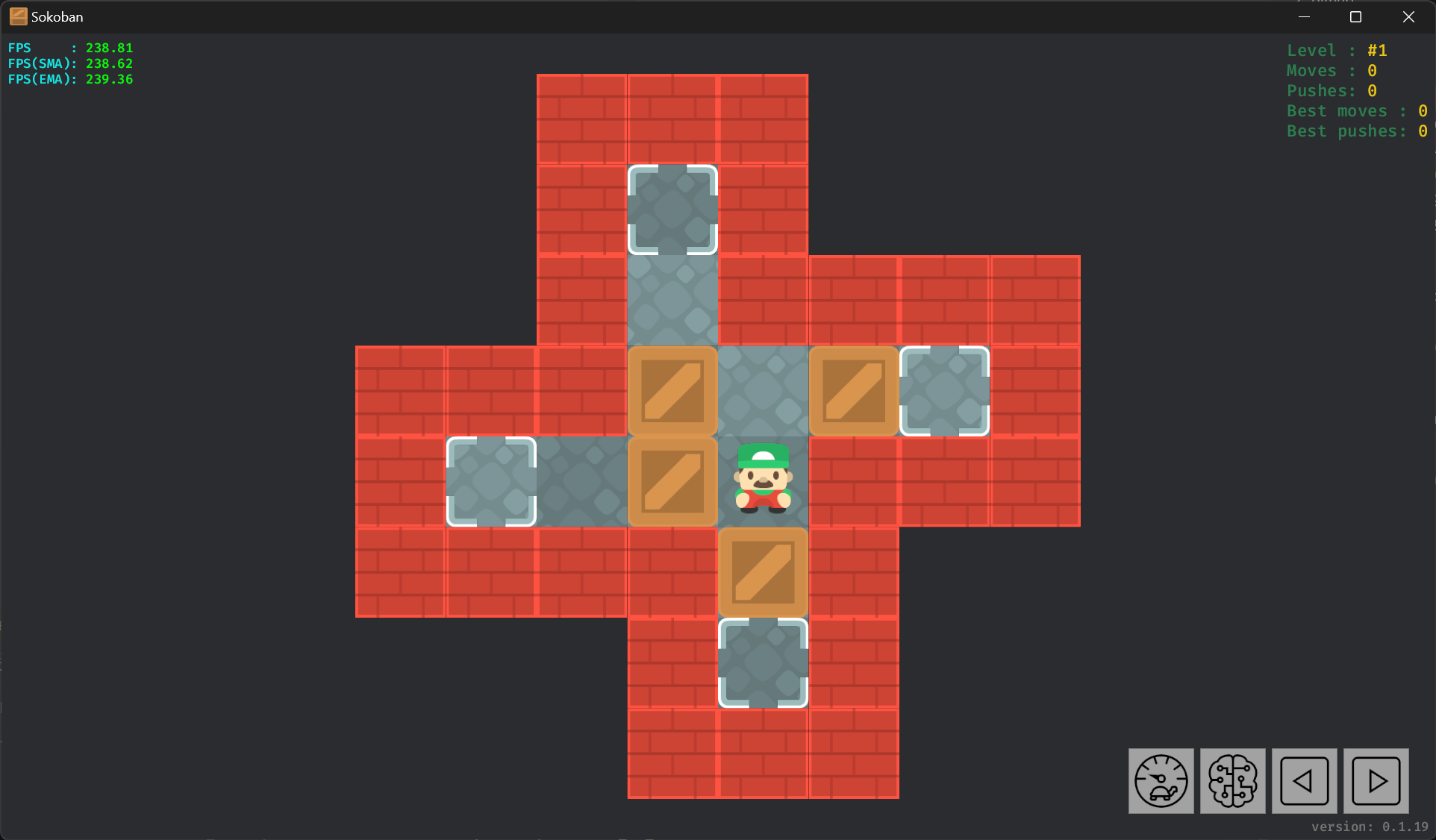关卡
XSB 格式
推箱子关卡所使用的 XSB 格式因其简洁和直观而受到了广泛的认可和应用, 最初由 XSokoban 所使用. 该格式使用 ASCII 字符来表示地图元素, 并支持注释和附加元数据.
以关卡 Boxworld #1 为例:

其 XSB 格式关卡的数据如下:
;Level 1
__###___
__#.#___
__#-####
###$-$.#
#.-$@###
####$#__
___#.#__
___###__
Title: Boxworld 1
Author: Thinking Rabbit
上面的关卡数据大致可分为以下几种:
- 第 1 行, 单行注释, 以
;开头. - 第 2-9 行, 地图数据, 使用 ASCII 字符表示.
- 第 10-11 行, 元数据, 包括关卡标题和作者的信息.
地图数据
| ASCII 符号 | 描述 |
|---|---|
<SPACE>/-/_ | 地板 |
# | 墙体 🧱 |
$ | 箱子 📦 |
. | 目标 🎯 |
@ | 玩家 👷 |
+ | 位于目标上的玩家 |
* | 位于目标上的箱子 |
其中地板一共使用了三种符号表示, 是因为连续的空格在某些在线论坛或邮件中可能被截断, 因此使用连字符(-)和下划线(_)来替代1.
元数据
第 10 行的 Title: Boxworld 1 可以解释为键为 title (不区分大小写), 值为 Boxworld 1 的元数据.
还有一种用于多行注释的特殊元数据. 内容通过 comment: 和 comment-end: 包裹. 这也是唯一支持值有多行的元数据.
!!! info
多行注释还存在一种以 comment: 和 comment_end: 包裹的写法, 与之前提到的多行注释不同,这种多行注释使用下划线(_)来替代连字符(-)分割单词.
本文将这种格式视为无效格式, 其可能是在批量替换 _ 和 - 字符时意外产生的.
游程编码 🗜️
游程编码(Run-length encoding, RLE)是无损数据压缩的一种形式, 常被应用于推箱子关卡和解决方案的压缩.
###
#.###
#*$ #
# @ #
#####
经 RLE 编码后可得:
3#
#.3#
#*$-#
#--@#
5#
可以看出, 虽然编码后的关卡有更小的体积, 但不再能直观地看出关卡的结构.
RLE 编码后的关卡通常还会使用 | 来分割行, 而非 \n. 使其看上去更加紧凑:
3#|#.3#|#*$-#|#--@#|5#
只需要对原本的语句进行修改即可提供对 | 分割行的支持:
for line in str.lines() { ... SKIP ... }
for line in str.split(['\n', '|']) { ... SKIP ... }
编码
下面是一个简单的 RLE 编码函数的实现:
pub fn rle_encode(str: &str) -> Result<String, EncodeRleError> {
let mut result = String::new();
let mut chars = str.chars().peekable();
let mut count = 0;
while let Some(char) = chars.next() {
if char.is_numeric() {
return Err(EncodeRleError::InvalidCharacter(char));
}
count += 1;
if chars.peek() != Some(&char) {
if count > 1 {
result.push_str(&count.to_string());
}
result.push(char);
count = 0;
}
}
Ok(result)
}
该方法不会使用括号包裹重复的相连子串以提高压缩率.
解码
下面是一个 RLE 解码函数的实现:
pub fn rle_decode(str: &str) -> Result<String, DecodeRleError> {
let mut result = String::new();
let mut length_string = String::new();
let mut iter = str.chars();
while let Some(char) = iter.next() {
if char.is_ascii_digit() {
length_string.push(char);
continue;
}
let mut token = String::new();
if char == '(' {
let mut nesting_level = 0;
for char in &mut iter {
if char == '(' {
nesting_level += 1;
} else if char == ')' {
if nesting_level == 0 {
break;
}
nesting_level -= 1;
}
token.push(char);
}
} else {
token = char.to_string();
}
let length = length_string.parse().unwrap_or(1);
result += &token.repeat(length);
length_string.clear();
}
if !length_string.is_empty() {
return Err(DecodeRleError::EndWithDigits(
length_string.parse().unwrap(),
));
}
if result.contains('(') {
return rle_decode(&result);
}
Ok(result)
}
其他格式
Sok
推箱子程序 Sokoban YASC 专用格式, 兼容 XSB 格式:
Boxworld 1
__###___
__#.#___
__#-####
###b-b.#
#.-bp###
####b#__
___#.#__
___###__
Author: Thinking Rabbit
请参见 Sok format · Sokoban Wiki.
MF8
中文论坛魔方吧2使用 MF8 格式:
[soko=8,8]
__HHH___
__H.H___
__H_HHHH
HHH$_$.H
H._$aHHH
HHHH$H__
___H.H__
___HHH__
[/soko]
特殊关卡
玩家不可达区域存在箱子

#####
# #
### ########
## *** # # #
# * * ## # #####
## *** ## # ## ##
### #### # # # #
# # # # ####$ $###
## ## # ## $...$ ##
##### # ## .@. #
# # # $...$ ##
########$ $###
# #
#####
存在只有空元素的行

# #
# # #
# # #
# # #
# # #
# # #
# # #
-
##########
#........####
# $$$$$$$# #
#.$......# #
# $$$$$$ # #
#......$+# #
#$$$$$$$ # #
# ####
##########
无完整外墙
部分推箱子程序支持无完整外墙的关卡.
在本文中, 这种关卡属于无效关卡. 但可以通过为其添加外墙的方式来转换为有效关卡.

* ** *
**
**@$.*
**
* ** *